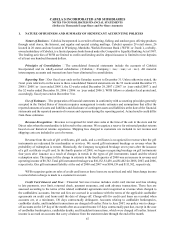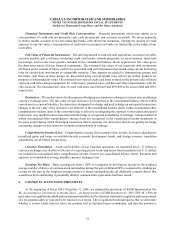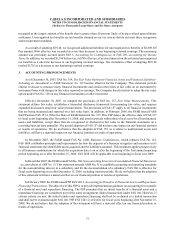Cabela's 2008 Annual Report Download - page 76
Download and view the complete annual report
Please find page 76 of the 2008 Cabela's annual report below. You can navigate through the pages in the report by either clicking on the pages listed below, or by using the keyword search tool below to find specific information within the annual report.71
CABELA’S INCORPORATED AND SUBSIDIARIES
NOTES TO CONSOLIDATED FINANCIAL STATEMENTS
(Dollars in Thousands Except Share and Per Share Amounts)
Land grants typically include land associated with the retail store and may include other land for sale and
further development. Land grants are recognized at the fair value of the land on date of grant. Deferred grant income
on land grants is recognized as a reduction to depreciation expense over the estimated life of the related assets of
the developments. In 2008 and 2007, we received land under land grants with a fair value of $5,015 and $19,000,
respectively.
Certain grants contain covenants we are required to comply with regarding minimum employment levels,
maintaining retail stores in certain locations, and maintaining office facilities in certain locations. For these grants
we recognize grant revenue as the milestones associated with the grant are met. For 2008 and 2007, we were in
compliance with all material requirements under these grants.
Economic Development Bonds – Economic development bonds (“bonds”) issued by state and local
municipalities that management has the intent and ability to hold to maturity are classified as held-to-maturity
and recorded at amortized cost. Other bonds are classified as available-for-sale and valued at their fair value. Fair
values of bonds are estimated using discounted cash flow projections based on available market interest rates and
management estimates including the estimated amounts and timing of expected future tax payments to be received
by the municipalities under development zones. These fair values do not reflect any premium or discount that could
result from offering these bonds for sale or through early redemption, or any related income tax impact. Declines in
the fair value of held-to-maturity and available-for-sale economic development bonds below cost that are deemed to
be other than temporary are reflected in earnings.
Credit Card and Loyalty Rewards Programs – Cabela’s CLUB Visa cardholders receive Cabela’s points based
on the dollar amounts of transactions through WFB issued credit cards which may be redeemed for Cabela’s products
and services. Points may also be awarded for special promotions for the acquisition and retention of accounts. The
dollar amount of related points are accrued as earned by the cardholder and recorded as a reduction in Financial
Services revenue. In addition to the WFB issued credit cards, customers receive points for purchases at Cabela’s
from various loyalty programs. The dollar amount of unredeemed credit card points and loyalty points was $106,159
and $70,955 at the end of 2008 and 2007, respectively. The total cost incurred for all credit card rewards and loyalty
programs was $118,269, $109,619, and $90,096 for 2008, 2007 and 2006, respectively.
Income Taxes – The Company files consolidated federal and state income tax returns with its wholly-owned
subsidiaries. The consolidated group follows a policy of requiring each entity to provide for income taxes in an amount
equal to the income taxes that would have been incurred if each were filing separately. We recognize deferred income
tax assets and liabilities for the expected future tax consequences of temporary differences between the financial
statement carrying amounts and the tax bases of our assets and liabilities. We establish valuation allowances if we
believe it is more likely than not that some or all of our deferred tax assets will not be realized.
Stock-Based Compensation – We adopted the provisions of FAS No. 123 (revised 2004), Share-Based Payment
(“FAS 123R”), on January 1, 2006, using the modified prospective transition method. Prior to January 1, 2006, we
accounted for stock-based payments under the provisions of Accounting Principles Board (“APB”) Opinion No. 25,
Accounting for Stock Issued to Employees, and related interpretations. Effective January 1, 2006, we also adopted
FASB Staff Interpretation FAS 123(R)-3, Transition Election Related to Accounting for the Tax Effect of Share-Based
Payment Awards, relating to transitional guidance on determining and reporting excess tax benefits from stock
options exercised.
Under FAS 123R, we recognize compensation expense as follows. For equity awards issued after January 1,
2006, compensation expense is estimated based on grant date fair value on a straight-line basis over the requisite
service period. For awards granted prior to, but not yet vested as of January 1, 2006, we estimated compensation
expense based on the grant date fair value estimated under the provisions of APB Opinion No. 25. Costs associated
with all awards are included in compensation expense as a component of selling, distribution, and administrative
expenses.
























